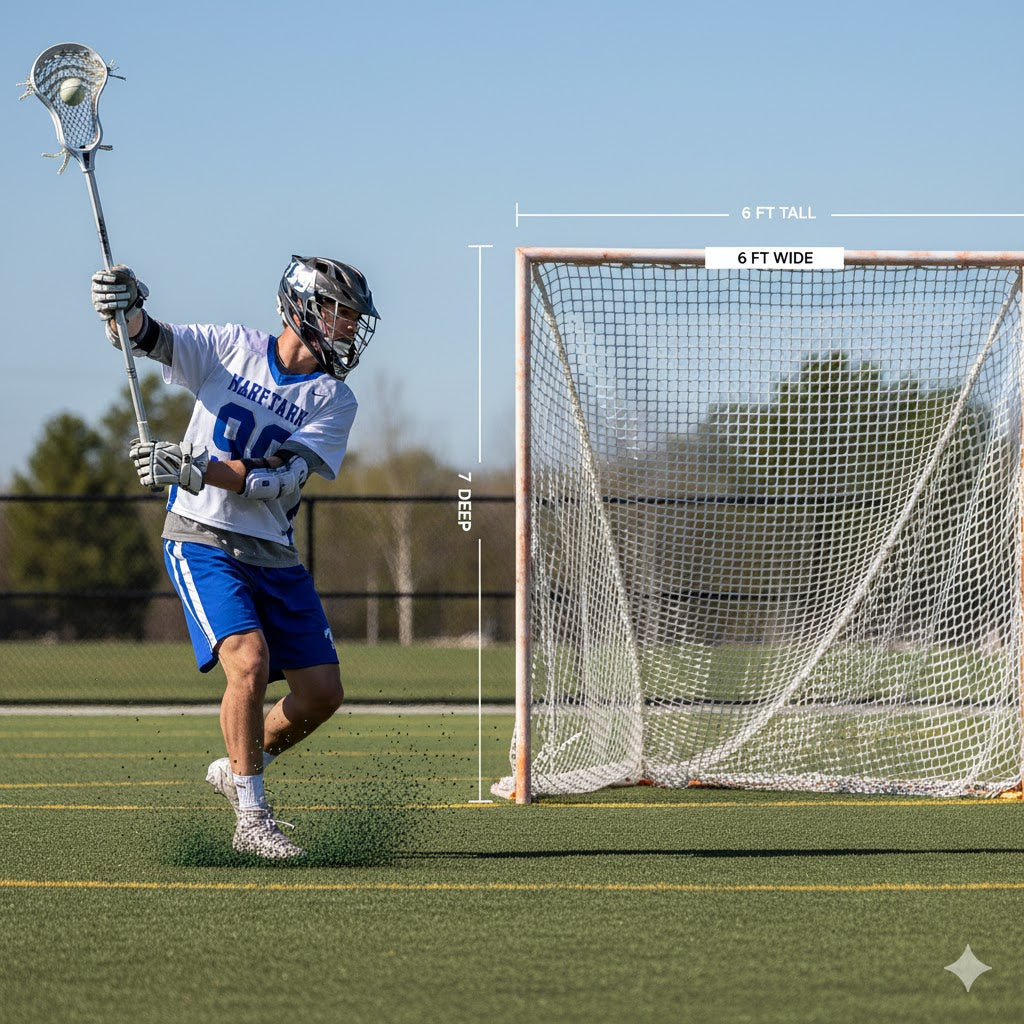

Lacrosse Goal Dimensions & Buying Guide
Right, so let's understand how big a lacrosse goal actually is. It depends on which lacrosse, field, or box. In field lacrosse, the goals usually measure 6 feet tall by 6 feet wide and the cage extends back around 7 feet. And in box goals are smaller, 4 by 4, but there are some lacrosse leagues that go wider.
The thing is that field and box lacrosse are different games, so when buying the goal, be careful. You need to start with the right dimensions.
In this guide, we'll break down field and box goal dimensions, what makes goals different in construction, and which one you should actually buy for your setup.
Regulation Field Lacrosse Goal Dimensions
Standard field goals, as we mentioned above, are 6 feet tall, 6 feet wide and around 7 feet deep. Both men's and women's lacrosse is played with these goal dimensions, whether it's professional or amateur level.
Usually, depth varies a bit by manufacturer, but is in the 6.5 to 7 feet range. The most important part is that the face is always 6 by 6. That is what NFHS, NCAA and World Lacrosse all agree on.
Why is it so important? Because players are training for those exact dimensions, hence shooting angles, goalkeeper positioning, etc, everything is built around 6x6, so a slight change feels like a wrong game.
The tip is to buy those dimensions, doesn't matter if you're buying for a club or a school team
Box Lacrosse Goal Dimensions
Box lacrosse happens indoors or in enclosed arenas usually. Goals in box are 4 feet by 4 feet. But the NLL and some other leagues they allow 4 foot 9 inch wide goals, so there is variation here.

Why the smaller size? Because the box is much faster and tighter game. Shots are coming from closer range usually. Less space to work with. So a smaller target keeps things competitive when goalkeepers are facing those point-blank attempts constantly.
The thing is different leagues mean different specs. You need to know what your competition requires before ordering anything. The tip is to check league regulations first.
Frames, Corners & Pipe Diameter
Right, so the goal construction is different based on if it's official or practice-grade.
Official Goals
Official regulation goals, they use 1.75 to 2 inch diameter pipe. Corners are welded square so the frame stays rigid under impact. These goals weigh over 100 pounds, sometimes closer to 150.
Why so heavy? Heavy means stable. You're not moving these much but they won't tip during play. Hence schools and clubs use these for matches.
Practice Goals
Practice goals use 1.5 inch pipe usually. Corners are rounded or bolted together. Weight is 15 to 25 pounds because they're portable. You can fold them, move them, or store them in the garage.
The thing is there's a tradeoff. They're not as durable. Bolted corners loosen over time. Lighter frames shift if the shot hits hard. But for backyard practice, they work fine.
Net Depth & Twine Thickness (Durability Guide)
Right, so net depth typically runs 6 to 7 feet for field goals. Box versions are shorter to match the smaller frame.

Twine Gauge
Twine thickness ranges from 2.5 to 6 millimetres.
-
2.5 to 3 mm: Lightweight option. Fine for backyard play or casual shooting. Won't last long under heavy use though.
-
5 to 6 mm: Heavy-duty thickness. Schools and clubs use this because it holds up to constant abuse. Costs more but you're not replacing it every season.
Mesh Size & Materials
Mesh needs to be fine enough that balls don't pass through. Larger mesh weighs less but tears easier. Smaller mesh is heavier and more durable.
Nets come in different colours. Material matters too; weather-resistant nylon and polyester hold up better outdoors. Cheaper nets fade and fray faster, hence investing in quality netting makes sense.
Which Lacrosse Goal Should I Buy?
Right, so here's a breakdown of what goal type works for what situation:
|
Type |
Size (H×W×Depth) |
Pipe |
Corners |
Weight |
Best for |
|
Field (official) |
6×6×~7 ft |
1.75"–2" |
Square/welded |
>100 lb |
HS, College, Club |
|
Practice (field) |
6×6×var. |
~1.5" |
Rounded |
15–25 lb |
Backyard/portable |
|
Box (indoor) |
4×4 (var.) |
League-dep. |
Square |
Varies |
Indoor/Box teams |
High school lacrosse uses the same 6 by 6 regulation size as college and professional play. Youth leagues for U8 or U10 sometimes use smaller training goals for learning but those aren't standard regulation.
The thing is you need to match your purchase to your actual needs. Buying for competition? Get regulation size with heavy-duty construction. Setting up backyard practice? Lighter portable models work fine.
Set-Up, Care & Safety Tips
So, once you've got your goal, you need to set it up properly.
-
Anchor your goals. Use sandbags or ground pegs. Goals tip over easier than you'd think and falling frame can hurt someone. Don't skip this.
-
Check welds and net ties before each session. Frayed nets or loose connections mean it's time for repairs. Better to catch issues early.
-
Store goals indoors when not using them. Weather damages frames and nets faster than regular play does. Rain, sun, snow - all wear things down.
-
Replace netting once the mesh frays or stretches. Loose net won't stop shots properly and can let balls through in ways that mess up practice. When you see holes or sagging, replace it.
Learn more in our How to Lace a Lacrosse Net
Choosing the Right Goal for You
Right, so to wrap this up: field lacrosse uses 6 by 6 foot goals, box lacrosse uses 4 by 4 foot goals. Match your purchase to your space, league requirements and level of play.
Buying for competition? Get regulation size with heavy-duty construction. Setting up backyard practice? Lighter portable models work fine and cost less.
The tip is don't cheap out too much on construction quality but also don't overspend on features you don't need. Buy what matches your actual use case.
See Field Models or Box Models
FAQs About Lacrosse Goal Dimensions
Q1: How big is a lacrosse goal?
Standard field lacrosse goals are 6 feet high by 6 feet wide. Depth is around 7 feet usually.
Q2: How big is a box lacrosse goal?
Box lacrosse goals are 4 feet by 4 feet. Some leagues use 4 foot 9 inch wide models though, depends on the league.
Q3: What size is a high school lacrosse goal?
High school uses the same 6 by 6 foot regulation goal as college and pro. No difference here.
Q4: What net thickness should I choose?
The thing is it depends on use. Choose 2.5 mm for light backyard use and 6 mm for heavy-duty if you're playing regularly. Thicker lasts longer.
Q5: What's the difference between an official and a practice goal?
Official goals are heavier with 2 inch welded frames. They weigh over 100 pounds. Practice models are lighter, around 15-25 pounds, with rounded or bolted corners. Hence practice goals are portable but less durable.
